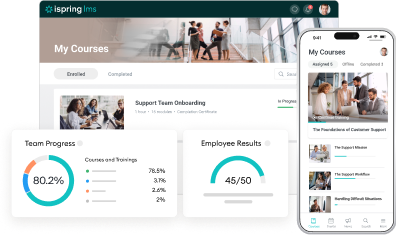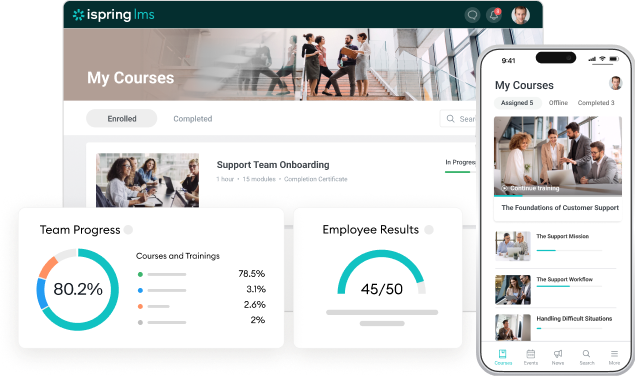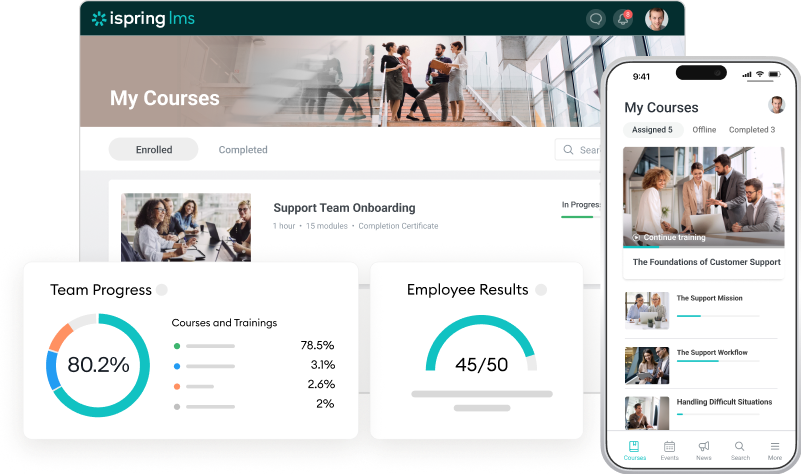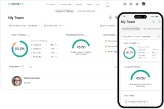Blended Learning: What It Is, Types, Examples, and More

The question of whether blended learning models are effective worries training professionals as much as those who wonder if blended scotch is a good thing. As with scotch, the answer depends on the balance. So, what is blended learning, what do we blend, in what proportions, and why has it been attracting so much attention over the past 10 years?
What Is Blended Learning?
Blended learning is an educational approach that combines traditional classroom methods with online learning activities to create an engaging and flexible learning experience. This approach enables learners to reap the benefits of both worlds, enjoying the advantages of eLearning while also benefiting from live interaction with educators and peers.
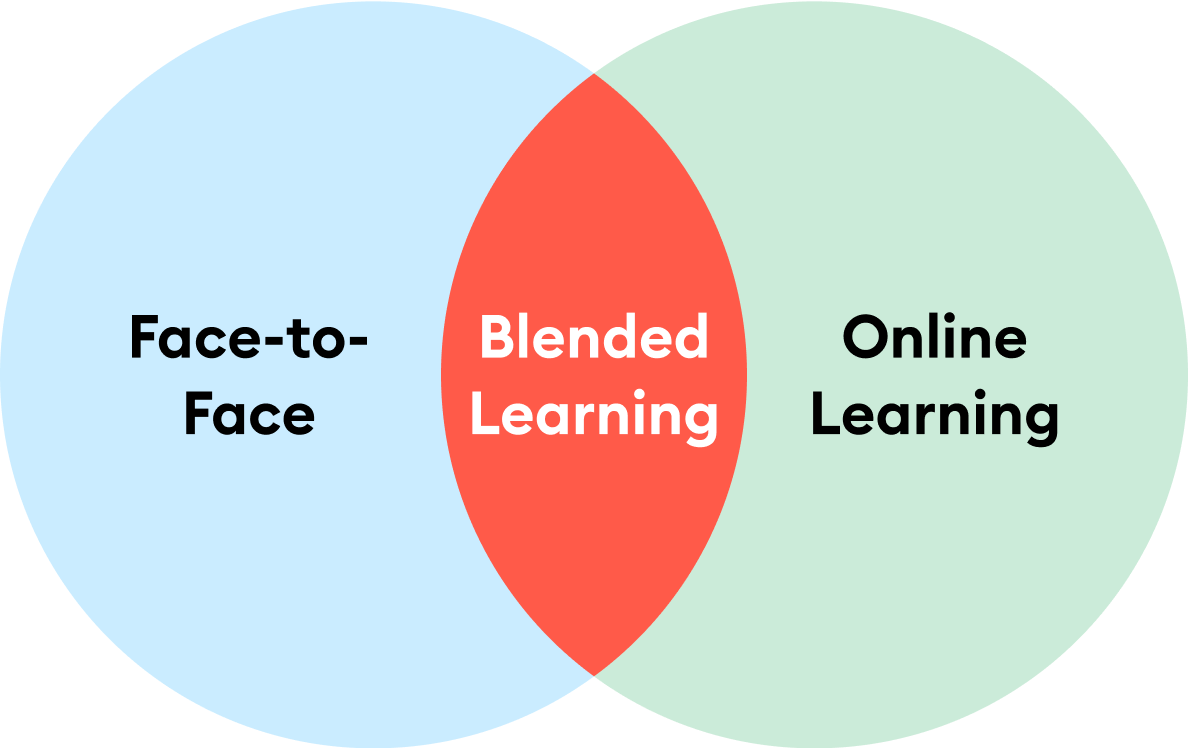
Sometimes, blended learning is confused with hybrid learning, which is a similar but not identical method. In the hybrid learning model, some students in a group are physically present in class, while others participate remotely in the training session. Although this approach also combines offline and online learning, it does so differently and is less nuanced. Despite that, the two terms are often used interchangeably.
Also, as cited in the recent Jisc report “Beyond blended,” all learning nowadays is potentially blended. As the concept continues to evolve, the vocabulary used to describe it also changes as we move forward.
Later in this article, we will describe the key blended learning models and share some real-life examples of blended learning in action. But first, why would you want to try this method?
Benefits of Blended Learning
Blended learning strategies might be trickier to develop and deploy than more straightforward programs. But the effort will pay off: when done right, this method is exceptionally beneficial for all parties involved.
Let’s explore the numerous advantages that blended learning experiences offer to both learners (students or employees) and organizations (schools, universities, or businesses).
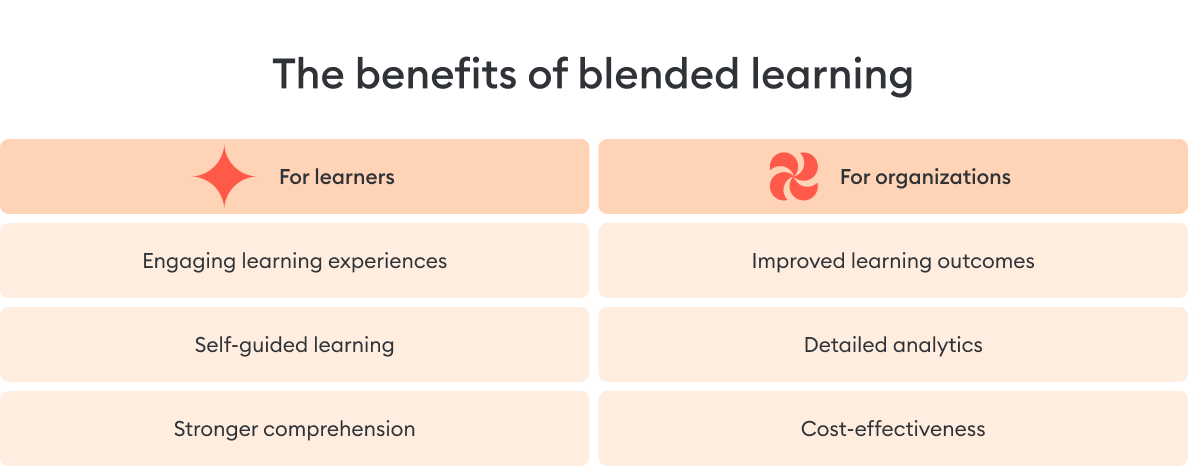
Benefits of blended learning for learners
Engaging learning experiences. Sitting in a room full of people and listening to an hours-long lecture can be challenging. Fortunately, you can learn the same material through interactive training sessions, engaging in simulated conversations, or playing game-like courses, which is an entirely different experience. Knowledge can be gained in different ways, and blended learning provides lots of tools to make learning fun through role-playing simulations, interactive quizzes, and more.
Self-guided learning. Between work, family, hobbies, and social life, people juggle numerous responsibilities, and education should facilitate, not hinder, this balance. A blended learning program offers a solution by providing round-the-clock access to courses. This enables learners to study whenever they wish and have more control over their schedules. Moreover, blended learning supports personalized learning paths, improving learning flexibility and effectiveness.
Stronger comprehension. Blended learning helps students understand and retain information better. With this approach, they study at their own pace, then use class time to gain deeper insights, practice hands-on learning activities, and get immediate feedback. As a result, students get the most out of their learning experience, which benefits the organization as well.
Benefits of blended learning for organizations
Improved learning outcomes. To truly improve learning outcomes, students must be actively involved in the educational process. Blended learning achieves this by combining various instructional methods and leveraging digital tools that make blended learning experiences more dynamic and accessible. This is how the approach empowers organizations to create engaging, adaptive, learner-centric training that brings noticeably better results.
Detailed analytics. How long did it take a learner to complete a quiz? How many attempts did they make? Do they have any assignments that are due soon? The answers may seriously affect your strategy, providing crucial data to make the necessary adjustments. With traditional learning methods, figuring such things out might be next to impossible.
Cost-effectiveness. Blended learning helps organizations significantly reduce the costs of their learning and development initiatives. With this approach, they can reach more learners while cutting down on travel and other expenses, but still maintain the benefits of quality face-to-face time. This makes blended learning the perfect choice for companies with smaller budgets, allowing them to make the most of their training programs.
That said, understanding exactly how blended learning works is essential to reap these benefits. But the variety of blended learning strategies, tools, and the need for balance can leave even seasoned learning professionals and L&D managers overwhelmed — which leads us directly to the next section.
Blended Learning Models
Blended learning is an umbrella term that describes a comprehensive educational approach. Within it, there is an array of models that share the same core principle but differ in details. Let’s take a closer look at each of the blended learning models and what they can be used for.
1. Face-to-face driver model
This blended learning model relies mostly on traditional classroom teaching but adds an online learning experience to improve training effectiveness. The teacher remains the central figure, and digital tools are employed as supplementary resources to deepen understanding, provide additional practice, or introduce innovative learning methods.
For example, advanced students might be given a challenging quiz or test, while those who are struggling to grasp the material can watch instructional videos.
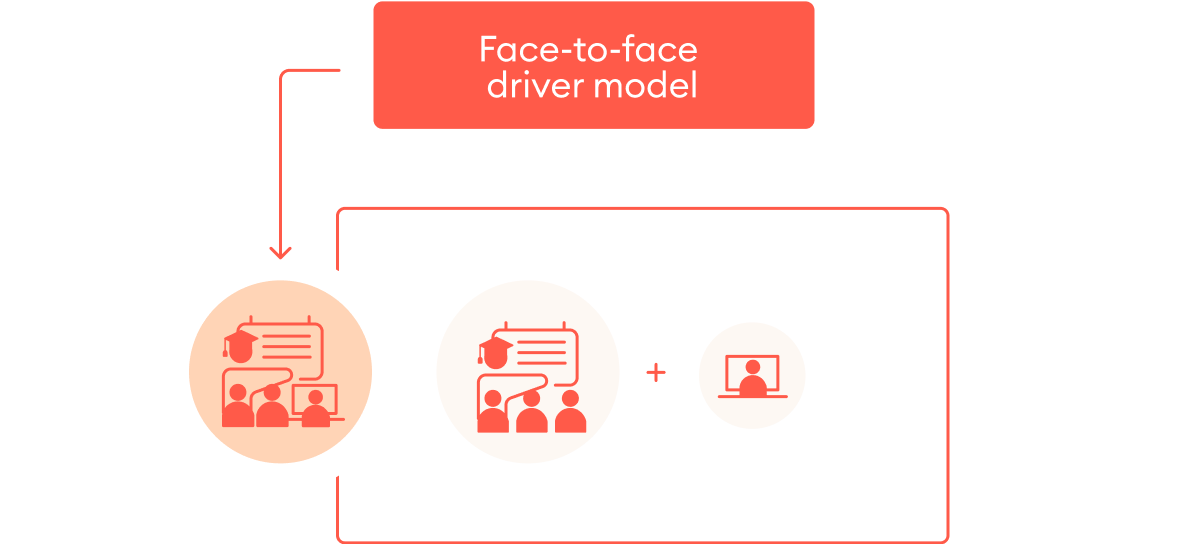
Best for: This model works well for groups of learners with differing skill levels, both in academic and corporate settings, and especially where hands-on practice is necessary.
2. Online driver model
This blended learning model contrasts with traditional brick-and-mortar studying because it relies almost entirely on digital delivery of the training. It combines both synchronous formats — such as live webinars and peer-to-peer training sessions — and asynchronous formats like self-paced study of eCourses. With this model, live face-to-face meetings are generally unnecessary but can be arranged if necessary.
Also read: Asynchronous Learning vs. Synchronous Learning
According to the online driver method, students primarily engage with their courses through online learning platforms, accessing lessons, assignments, and resources from any place where there’s an internet connection. The trainer takes on a supportive role, stepping in to provide additional help or clarification as needed.
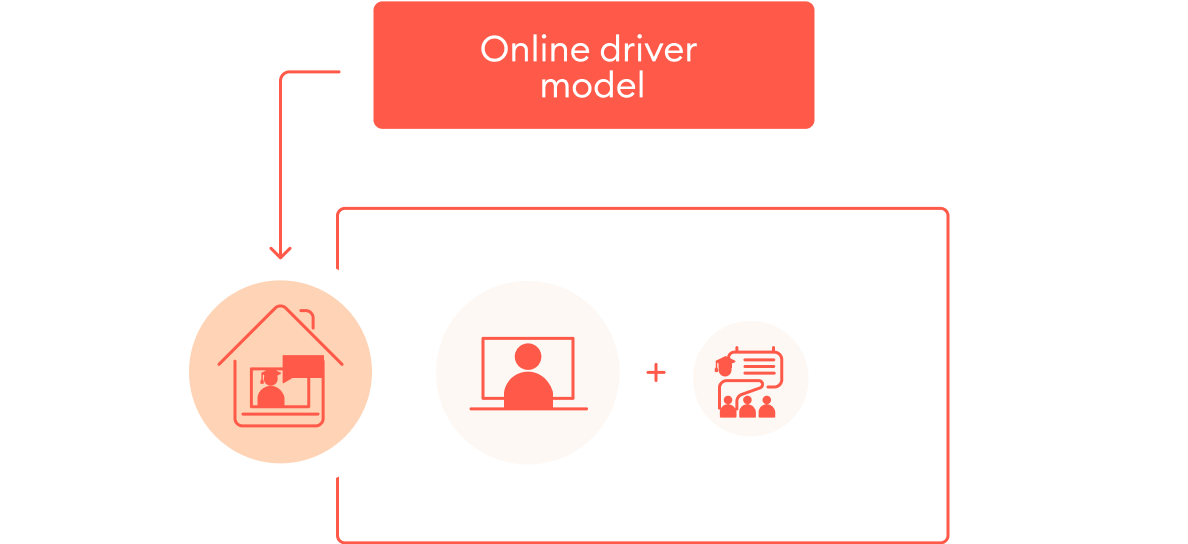
Best for: Due to its online-first nature, the model is perfect for distributed and remote teams since it provides the greatest degree of flexibility. It’s also a great choice for companies that can’t afford a place to hold regular training sessions because it minimizes in-person interaction.
3. Rotation model
In this blended learning model, students rotate through different learning stations on a set schedule. These stations can include a variety of learning methods, such as direct instruction from a teacher, group projects, individual online learning experiences, and hands-on activities.
This model includes several types:
- Station rotation model. The class is split into small groups, and each group spends a set amount of time on a given activity or “station.” Groups rotate, changing activities and making sure that each group goes through every station during a session.
- Lab rotation model. This model is generally similar to the station rotation model. The difference is that in this type, the online component of the session takes place in a dedicated computer lab rather than in the main classroom.
- Individual rotation model. Students rotate through stations or activities according to a personalized learning path. The schedule is based on the student’s learning progress, needs, and preferences, and each person only stops at the “stations” that are relevant to them.
The rotation blended learning model offers a structured yet flexible way of learning, catering to the diverse learning needs and styles of students within the same classroom. Also, switching between activities and learning methods during a session helps to keep things fresh.
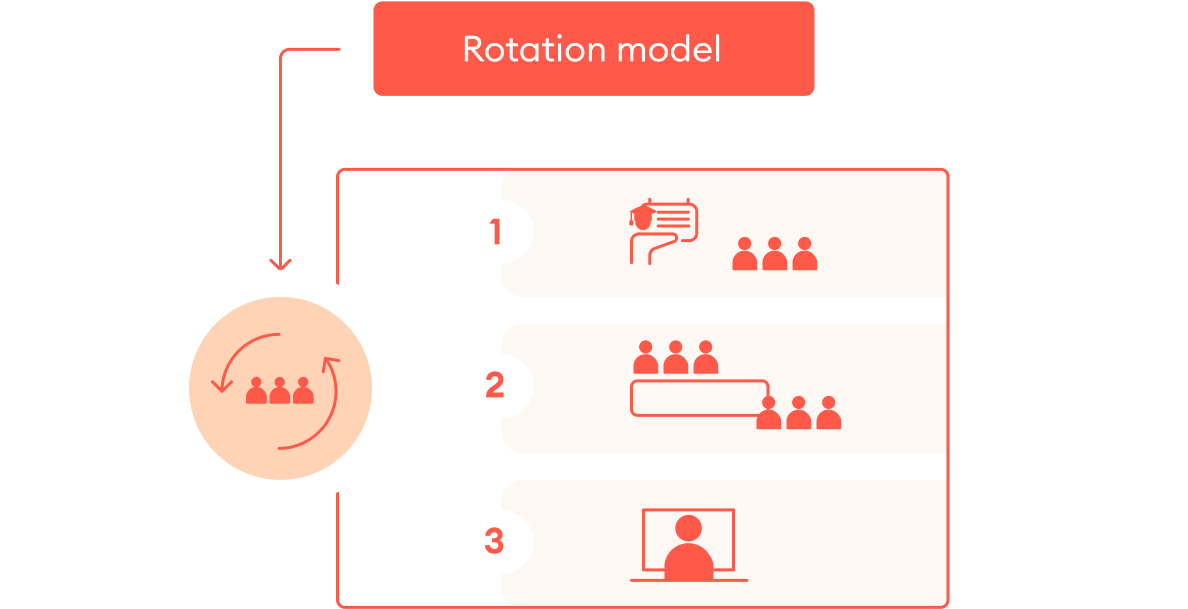
Best for: This model is perfect for organizations that struggle to keep learners engaged with traditional learning methods. It’s also great for learner groups with mixed skill levels because it allows them to address skill gaps without holding back the more advanced students.
4. Flipped classroom model
In this popular blended learning strategy, students first familiarize themselves with new learning content on their own, typically through video lectures or reading assignments. This approach allows them to free up classroom time for interactive activities such as discussions, projects, and hands-on exercises. This ensures deeper, more practical engagement with the material at live sessions because students apply new knowledge and skills under the teacher’s guidance. The model is sometimes considered another type of rotation model as it also involves rotation between “stations.”
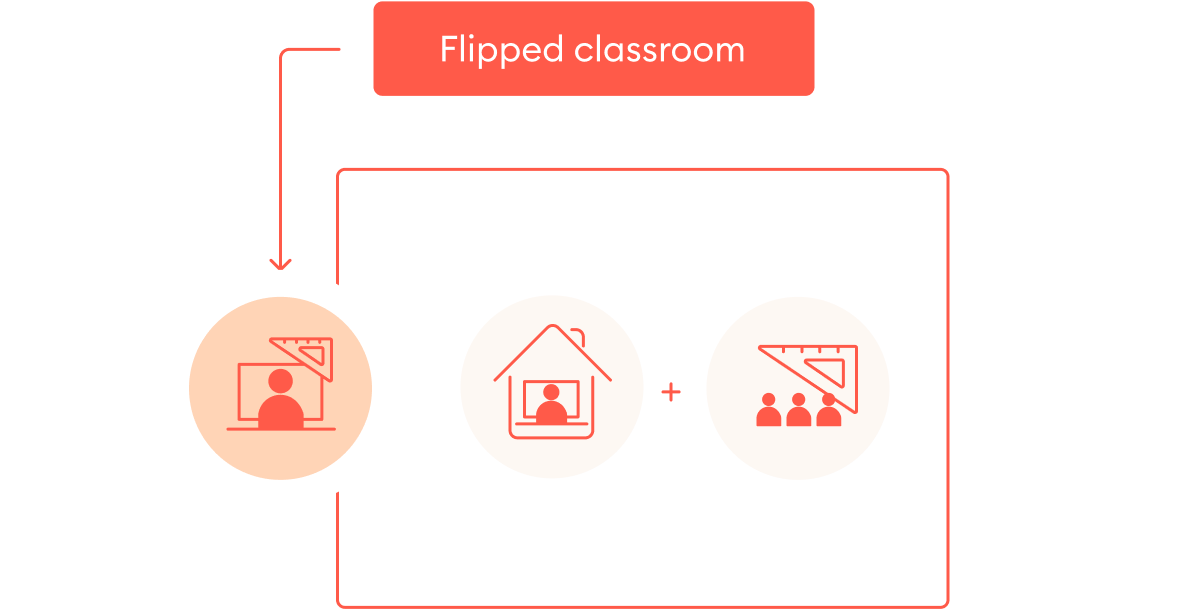
Best for: The flipped classroom approach is suitable for learners who prefer to study new material at their own pace and practice during live interaction — particularly adults. If your course includes dealing with topics that call for debates and discussions, the flipped classroom model can be a great choice.
5. Flex model
The flex blended learning model represents a learner-centered approach where instruction is primarily delivered online, allowing students to control the pace and learning path. According to this model, students typically do coursework on customized online platforms on-site or remotely, with face-to-face support from teachers made available as needed. Teachers act more as coaches, providing help and guidance rather than direct instruction.
This is somewhat similar to the online driver model but with more student-teacher interaction, including in-person communication. For example, students might work through learning modules in a physical classroom with a teacher present, and ask for help when needed.
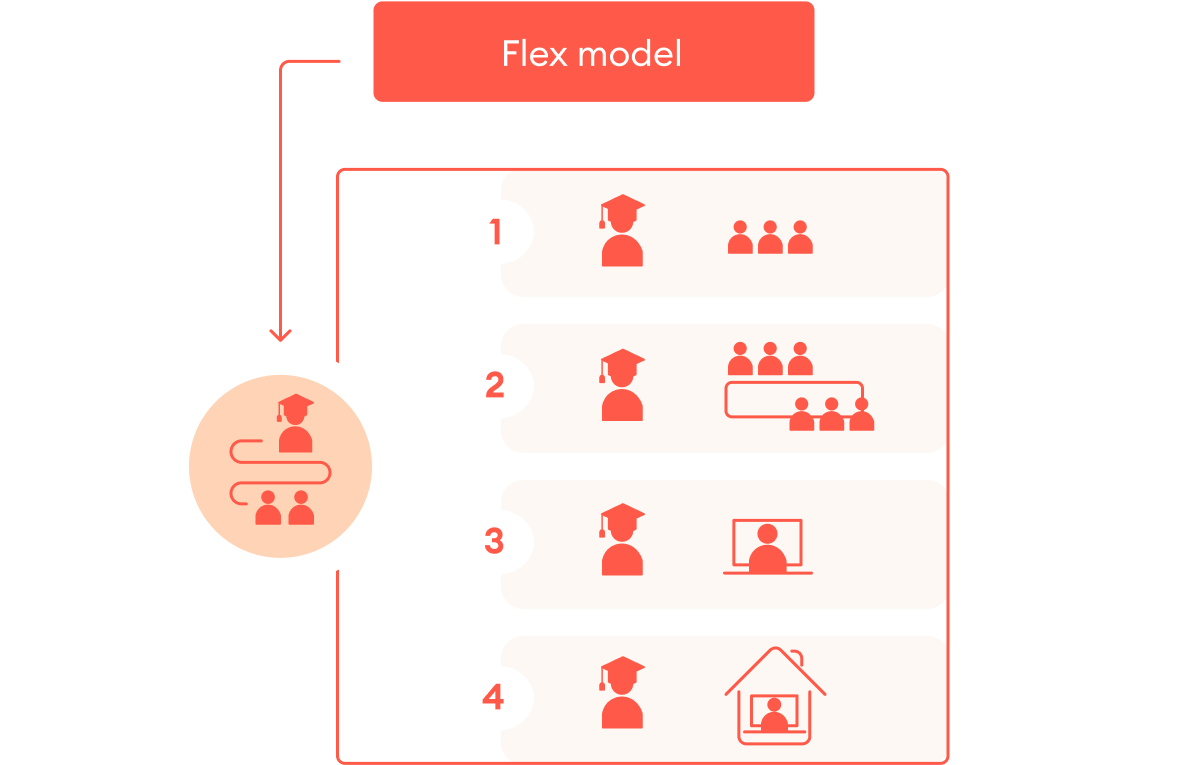
Best for: The model’s greatest strength is exceptional flexibility. This feature makes it a great choice for self-motivated adult learners and groups with differing skill levels and learning styles.
6. Enriched virtual model
This is another blended learning model that mainly utilizes online activities but includes some face-to-face interaction in the mix. In this model, students mostly complete coursework online on a digital learning platform. However, they also have to attend in-person teacher-led sessions that take place according to a set schedule. These sessions typically involve discussions, assessment activities, or hands-on practice.
Unlike the similar flex and online driver models, the enriched virtual model involves mandatory face-to-face sessions, which ensure that learners stay engaged and motivated. Think of a language course where students do most activities online but meet once a week at a discussion club to practice what they’ve learned.
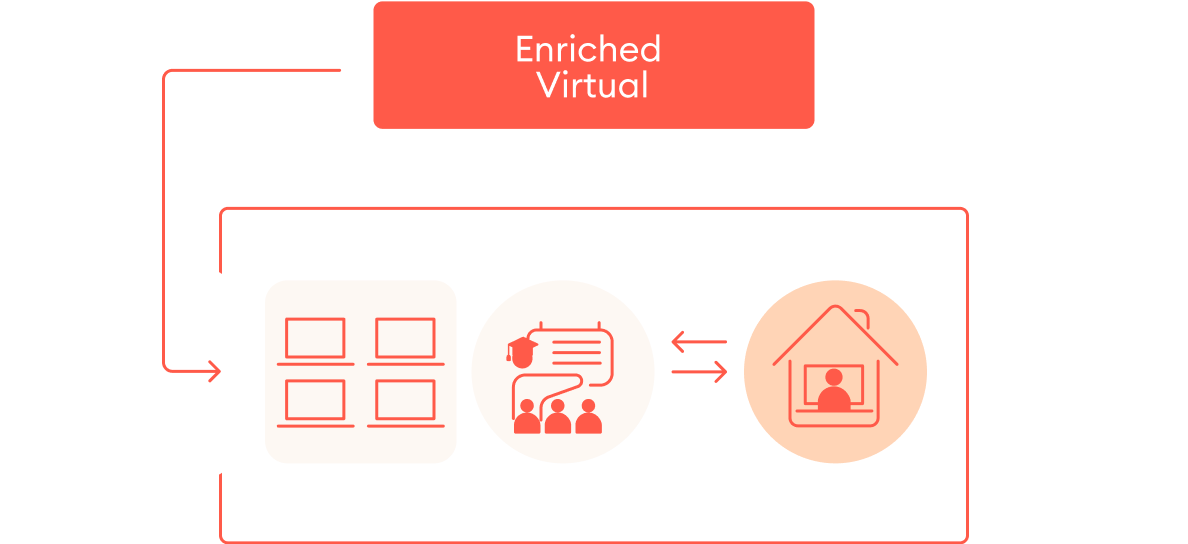
Best for: The enriched virtual model can be a good fit for advanced students who enjoy learning online at their own pace but need an occasional nudge. It will also work for learners whose motivation starts to wane without regular in-person interaction, and for teams with members on differing or busy schedules.
7. Online lab model
With the online lab blended learning model, learners complete all coursework online on a learning platform while physically present on-site. There is also a supervisor in the same space, but they only address technical issues and keep things running while all of the learning happens online. The supervisor is not an expert on the subject, so this model is also an online-first approach.
For example, employees can take an online product training course while sitting in a training room at work to ensure that everyone participates. If any technical problems arise, it will be the supervisor’s job to address them promptly.
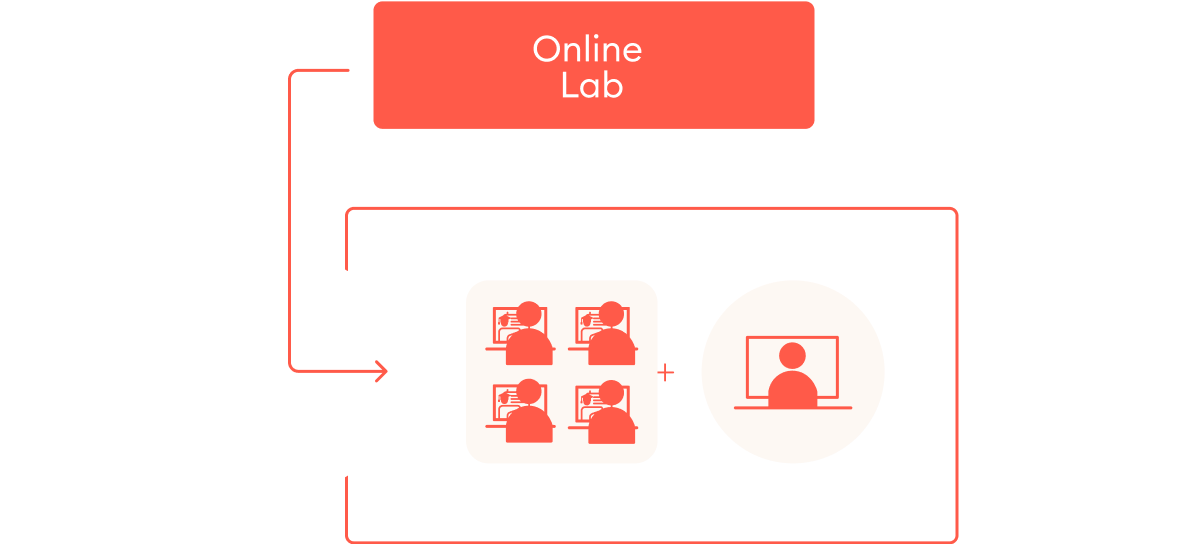
Best for: In academia, this model can be used for courses offered outside the curriculum, or when there is a shortage of teachers of a particular subject. In corporate settings, it’s a good fit for mandatory training where participation is necessary, like compliance training or product training courses. It’s also a good option for learners lacking technical skills to navigate online platforms confidently on their own.
Other popular learning models that might be considered blended learning include the self-blend model and the la carte model. However, the face-to-face component is not necessarily present in both of them, which is why they are sometimes not regarded as “true” blended learning models.
How to Choose a Model
As mentioned earlier, the variety of blended learning strategies can be overwhelming. Here’s a quick checklist on how to choose a blended learning model for your needs.
| How to choose a blended learning model: Aspects to consider | |
|---|---|
| Learning goals | Theoretical knowledge, practical skills, or collaboration? |
| Learning formats |
|
| Available tools |
|
| Target audience |
|
| Available resources |
|
For example, if you have a group of factory workers who need to complete compliance training quickly, an online-first program with mandatory supervision will be the best choice. In this case, the online lab model can be a great fit.
For a group of office workers who are taking an optional language course, an even blend of the online and offline components will work best. In this example, you can opt for the face-to-face driver or the enriched virtual model, depending on the resources available on both sides.
3 Real-Life Examples of Blended Learning in Action
Blended learning has been successfully implemented by various companies to enhance corporate training. Here are some of the most notable examples of the real-world application of blended learning strategies.
Boeing
Blended learning model: Flipped classroom
Boeing sought to improve its Capture Team Leader (CTL) training by making it more relevant and reducing classroom time. They implemented a blended learning solution that included eight web-based training lessons to be completed before a four-day live course. Blended learning allowed participants to gain foundational knowledge online and practice skills before attending in-person sessions, resulting in a more efficient and effective learning experience.
Deloitte
Blended learning model: Enriched virtual
Deloitte leverages a blended learning program to upskill employees through 12-week in-person boot camps, eLearning modules, and peer learning communities called “guilds,” where employees can learn from each other. For non-technical courses like soft skills development, Deloitte uses an employee-generated content model, allowing employees to create learning modules independently.
The company is also experimenting with generative AI serving as a tutor within a blended learning strategy to enhance real-time learning experiences through interactive dialogue.
Castle
Blended learning model: Flex
Castle, an energy construction services provider in North America, transitioned from time-consuming in-person training to a blended learning approach using iSpring Suite. They digitized safety and compliance training, reducing training costs and onboarding time while maintaining quality. Thanks to blended learning, Castle streamlined training processes, improved engagement among project-based employees, and minimized costly downtime across fluctuating workforce sizes.
How to Launch Blended Learning in 5 Steps
Assuming that a blended learning program is your ideal choice — what’s next? Here’s a detailed guide on how to launch it in your organization.
Step 1: Set blended learning goals
Determine what goals and objectives you plan to achieve through a blended learning program. For example, you might want learners to become more involved and independent in their education. In this case, models with a stronger online component will be a good fit. Or you might wish to provide more collaborative opportunities for students or employees to develop their social skills. If this is the main focus, regular in-person meetings will be key.
Step 2: Choose a blended learning model
Based on your goals, choose the blended learning model that best aligns with your needs. To make a more informed decision, also consider the following aspects:
- Learning formats: mostly online, mostly offline, or a mix.
- Available tools (more on that a bit later)
- Target audience(s), their preferences, and needs: office workers, remote workers, students, etc.
- Available resources: staff availability, budget, training rooms, computer labs, etc.
If several blended learning models look like the right fit, you can endeavor to combine them into a single strategy. But be ready to maintain each model consistently over time — and don’t forget that different learning models might require various tools and classroom designs.
Step 3: Get the right tools to create and deliver content
To launch the online part of blended learning, you’ll need special software. While every company and academic institution has unique requirements, two tools will be necessary in most cases: an authoring tool for creating online course content and a learning management system (LMS) for distributing this content and tracking learner progress and results. Let’s take a closer look at both.
Authoring tool
Given the flexible and customizable nature of blended learning strategies, it’s important to have a tool that enables you to develop and update eLearning materials quickly. If you’re new to instructional design and want to create learning materials hassle-free, try iSpring Suite. This intuitive tool works as a PowerPoint add-in, so the interface is probably familiar, and you can start creating content right away, with no special training.

iSpring Suite will help you create better learning experiences by allowing you to:
- Create engaging slide-based online courses.
- Build interactive quizzes and tests with 14 types of questions.
- Record and edit video tutorials.
- Create role-plays and dialogue simulations.
- Add interactivity to theoretical study materials.
- Collaborate on learning materials with co-creators.
- Publish courses in LMS-compatible formats, such as SCORM and xAPI.
Here’s an example of an online course made with iSpring Suite. In this course, various elements are combined to create an engaging learning experience. The course also features a step-by-step recipe that learners can try out in their kitchens or on-site at a live workshop. All this makes it ideal for blended learning programs.
Liked this one? Get a 14-day free trial and start creating versatile online courses for your blended learning strategies right away.
Learning management system (LMS)
Learning management systems (LMSs) are used to store training content, deliver it to learners, and generate reports that help you see how effective your training is.
Some LMSs can only provide learners with assigned eCourses, which is also referred to as asynchronous learning. Other solutions have a larger number of features, allowing you to conduct live online learning sessions and more.
Plus, there are some LMSs that also enable you to plan and monitor offline session attendance through a convenient dashboard, eliminating the need to juggle several tools simultaneously. Such multifunctional platforms are a perfect fit for blended learning. Besides, there are other benefits of learning management systems, such as storing a knowledge base, quickly visualizing qualifications, and more.
If you’re just getting started with eLearning, here is a quick look at what you can do with an LMS that’s suitable for blended learning:
- Access courses anywhere, at any time, on any device.
- Easily create study materials with native authoring tools.
- Add students and assign courses automatically.
- Use different learning formats — real-time or self-paced learning.
- Share ideas and collaborate right on the platform.
- Use games and interactivity to keep learners engaged.
- Track your learners’ progress in real time.
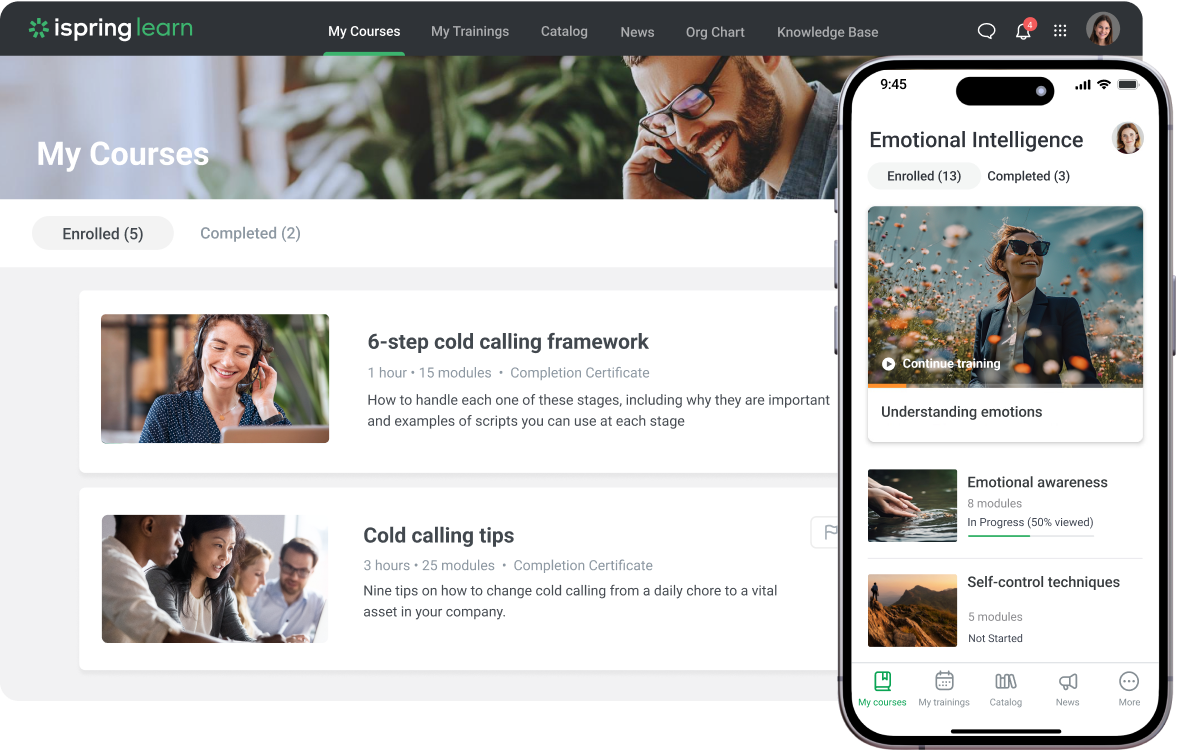
iSpring LMS is an example of a platform that meets all these requirements, making it a great choice for blended learning. The LMS has all the essential features needed to launch and manage blended learning programs: native integrations with conferencing tools, convenient planning of both online and on-site training sessions, automatic reminders, attendance reports, and much more.
Plus, there’s a native mobile app that lets you access the platform whenever and wherever you want. Such functionality eliminates the need to use other tools, so you won’t have to worry about endless spreadsheets, calendars, email services, and any other additional tools. The setup is simple, and there’s also a dedicated support team ready to answer your questions and help you resolve any issues 24/7. You can get a 30-day free trial and test-drive iSpring LMS’s diverse capabilities and features for yourself.
Step 4: Redesign your learning environment
Depending on the blended learning model you choose, you might need to redesign your learning space setting. For example, it might be necessary to set up or allocate breakout rooms for in-person sessions, install additional equipment, such as whiteboards or smart screens, etc. For models with a strong offline component, having sufficient physical space that learner groups can occupy regularly is also a must. Besides, you’ll need to make sure that the overall training space design motivates students to engage in your learning programs and keeps them positive.
Step 5: Launch blended learning and watch the metrics
Let your learners in – you’re ready! Now, your job is to organize the learning process effectively and support your audience’s learning experience. After the launch, watch the relevant metrics such as engagement rates, completion rates, etc. closely and adjust the program if needed.
And yes, be patient and don’t expect immediate effects. Remember, on average, it takes at least a few weeks for blended learning programs to yield some results.
Key takeaways:
- Launching a blended learning program is a multi-step process. Following each step carefully ensures that everything will work smoothly.
- The five steps to launch blended learning at any organization typically are: setting goals and objectives, choosing the right blended learning model, picking the right tools, redesigning the learning environment if necessary, and, finally, launching the program.
- After the launch, it’s essential to watch the relevant metrics, make adjustments when needed, and keep in mind that blended learning doesn’t yield immediate results.
Challenges of Implementing Blended Learning
As with any training program, implementing blended learning has its challenges. Here are the most common ones — and how you can overcome them.
Adopting the Technology
Challenge: Blended learning requires adequate technical equipment. So, organizations without updated technology and students lacking access to devices may have difficulties adopting it. Also, both trainers and learners might struggle with insufficient technical proficiency.
How to overcome it: Choose blended learning models that fit your current technical setup. Opt for user-friendly tools with intuitive interfaces to reduce technical barriers and help both educators and learners adapt more easily. If needed, invest in upgrading your infrastructure to support the program.
Planning and Logistics
Challenge: Blended learning involves managing both online and in-person activities, which makes planning more complex. Common issues include uncertainty about schedules and whether learners have completed their assigned online tasks.
How to overcome it: Use a learning management system (LMS) to streamline planning and management. An LMS lets you monitor progress, schedule sessions, send reminders automatically, and coordinate both components without additional tools.
Motivation and Feedback
Challenge: Blended learning works best with motivated, self-disciplined learners. Those who need supervision may struggle to stay engaged, risking lower completion rates. Limited face-to-face interaction can reduce engagement, teamwork, and the quality of feedback.
How to overcome it: Analyze your learners before starting and adjust the program accordingly. Incorporate strategies to boost engagement and provide timely feedback, thereby ensuring that learners stay motivated throughout the course.
Staff Training
Challenge: Educators often need to use several technical tools in blended learning, which can be challenging without sufficient skills. Insufficient training can impact the effectiveness of the program.
How to overcome it: Limit the number of tools used to make it easier to learn — an authoring tool and an LMS are usually sufficient. Provide staff with training on all necessary software and hardware. Choosing user-friendly tools will also simplify the training process.
What Tools Do You Need for Blended Learning?
As mentioned above, you can launch a blended learning program with just two tools: a content authoring tool and a learning management system. This is an ideal setup if you want to make the process hassle-free. However, it isn’t the only possible approach.
Let’s take a closer look at the entire array of tools used in blended learning.
Content authoring tool
An authoring tool allows you to create learning materials, such as presentations, video tutorials, infographics, and full-fledged eLearning courses. While there is a great number of content authoring tools on the market, they differ in features, interface, ease of use, and other aspects. One example of an authoring tool that’s suitable for creating materials for blended learning is iSpring Suite.
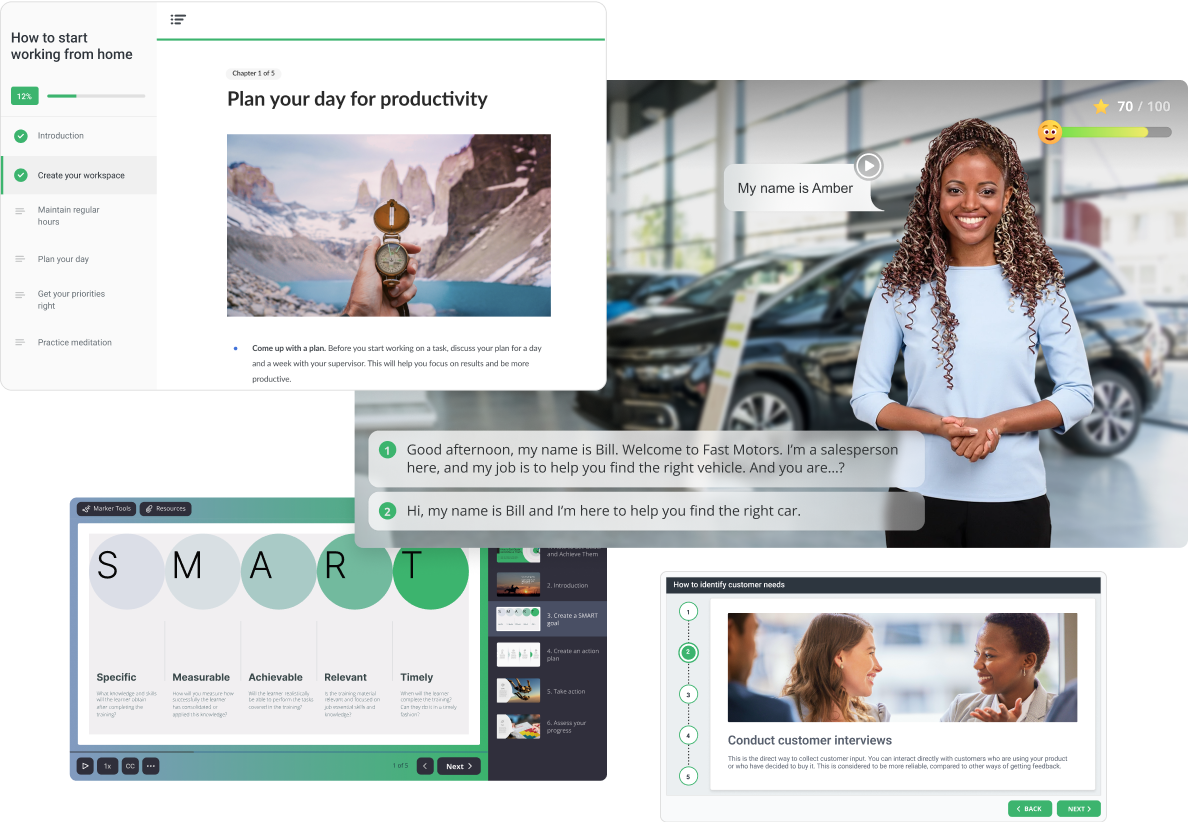
Besides having all the necessary features to build high-quality learning materials, it also natively integrates with the iSpring LMS — which makes launching and managing a blended learning program so much easier.
Learning management system (LMS)
A learning management system is a comprehensive solution for managing eLearning programs. Yet again, there is a vast variety of these tools on the market to suit virtually every eLearning strategy, learning goal, and budget. But not all LMSs can handle blended learning properly.
To do that, a platform must have certain features, such as scheduling and tracking, flexible learning paths, and advanced reporting. iSpring LMS is a prime example of such a platform, making it a go-to solution for blended learning programs in a variety of industries.
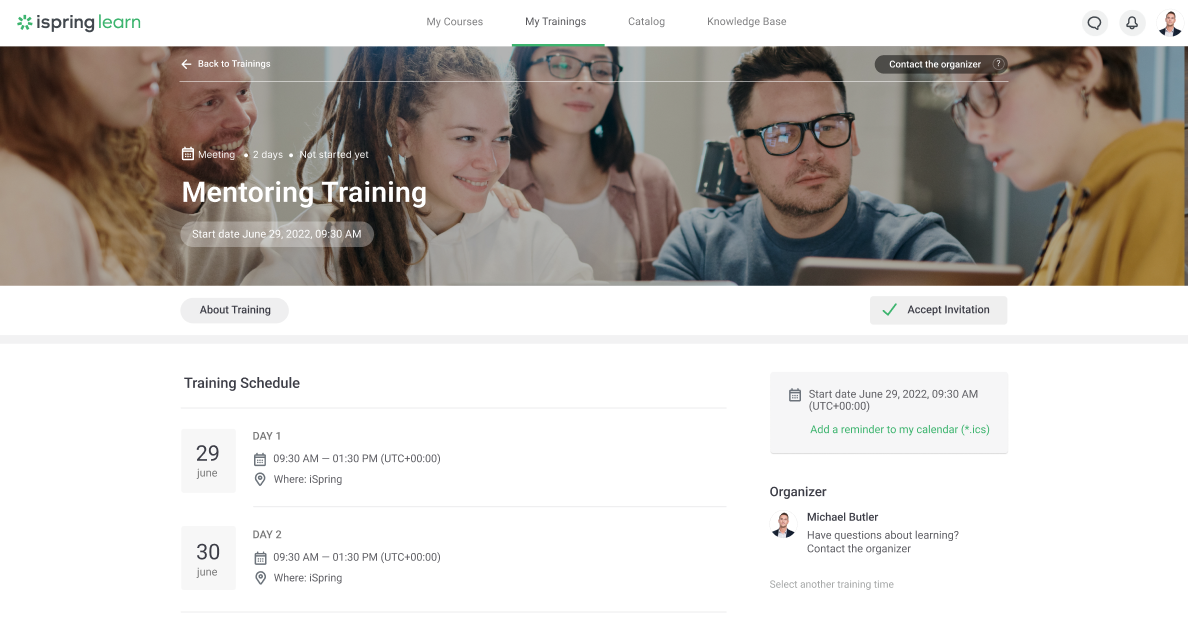
Plus, depending on the blended learning model you choose, you might also need the following additional tools.
Webinar and conferencing platform
If your blended learning strategy includes webinars and real-time online group sessions, you’ll also need a webinar and a conferencing platform. The most popular ones include Zoom, MS Teams, and Google Meet, but other options are also feasible.
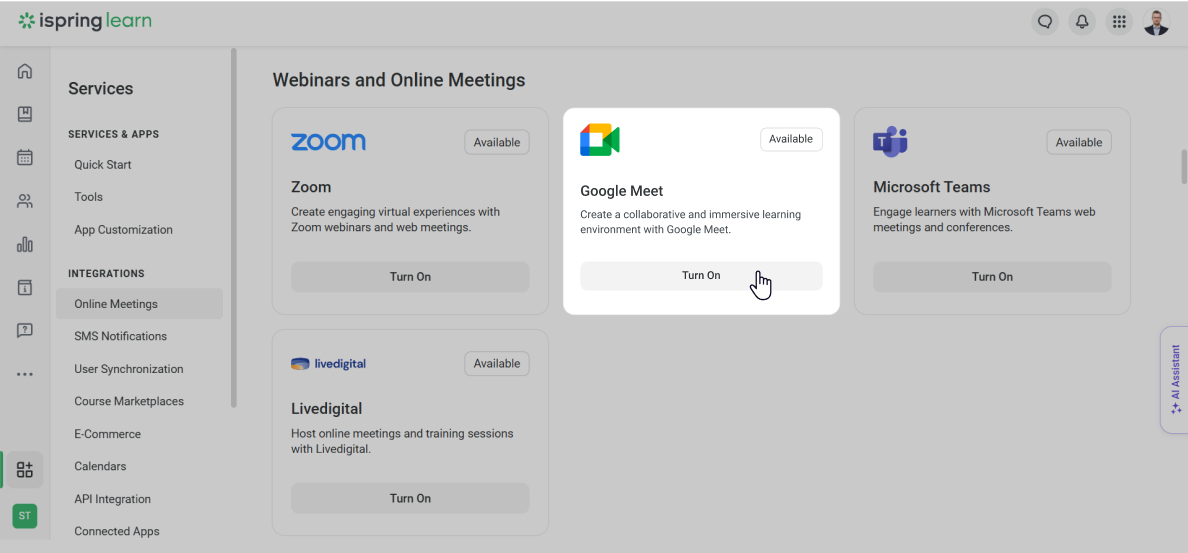
If you’re going to use an LMS, look for one that integrates easily with popular conferencing software, such as those mentioned above. This way, you’ll be able to schedule and run live online events right in the LMS and track attendance right there as well.
Analytics tool
Analytics is an essential part of any learning program because it allows you to see the full picture and make data-informed decisions about your strategy. Tools such as Tableau and Power BI help track student attendance, progress, and other metrics for both online and offline activities. But most LMSs have their own built-in analytics tools.
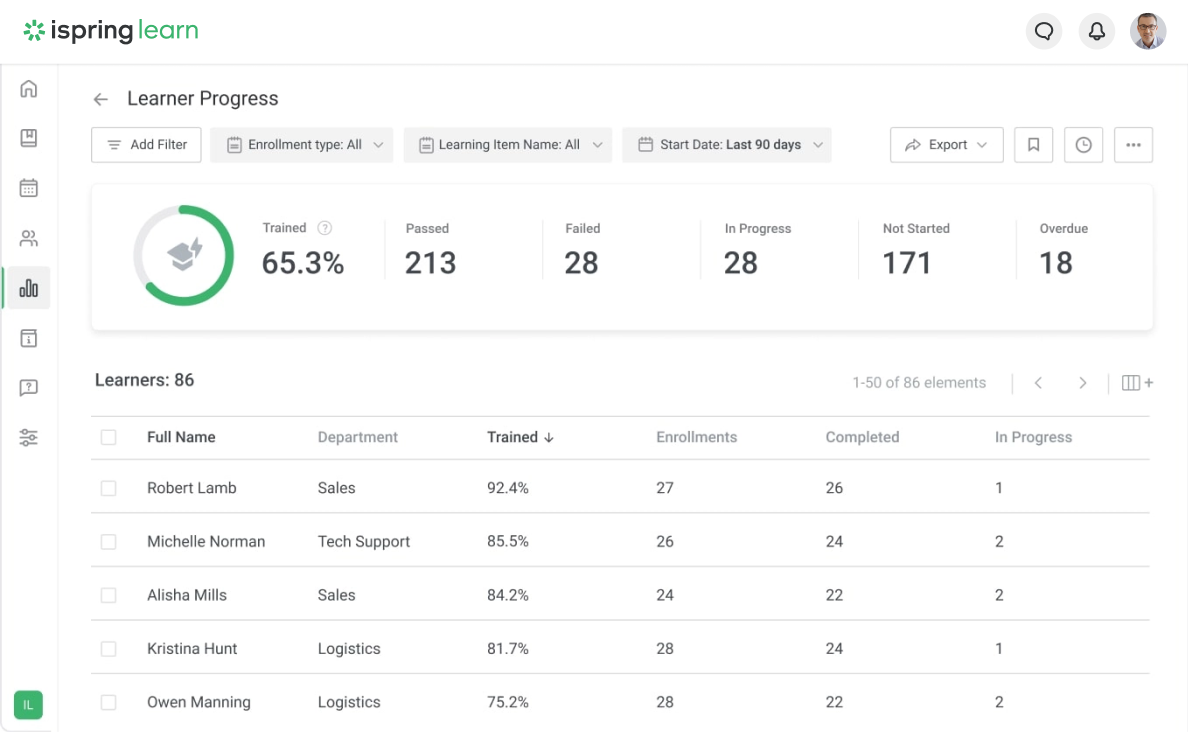
Typically, such built-in tools are powerful enough to make it unnecessary to use third-party analytics software. Having it all in one place makes managing blended learning programs a much quicker and less cumbersome process.
Simulation tools or sandboxes
In blended learning programs, hands-on practice is an integral part. While you can organize on-site events to demonstrate and practice the real-world application of knowledge and skills that have been learned, doing this online is also possible. Simulations, role-plays, virtual labs, and sandboxes are some examples.
Some industries require specialized software for these activities. For instance, the aviation industry uses flight simulators, the healthcare industry requires medical simulators, and the IT industry uses so-called sandboxes. But you can also create some simulations and role-plays with an authoring tool.
Here’s an example of a bank dialogue simulation made with iSpring Suite.
Measuring the Impact
Blended learning has numerous benefits for both learners and organizations. But how can you tell whether your strategy is actually hitting the mark? If we’re talking about business, here are a few concrete metrics you can use to assess the effectiveness of your blended learning programs in corporate training and beyond.
- Return on investment (ROI). The crucial metric that helps you assess whether the resources you allocate bring value — and exactly how much.
- Engagement rate. This one indicates how much learners are enjoying your program based on their interactions with learning materials and participation in events.
- Onboarding time. In corporate training, this is the metric that shows you how quickly an employee takes to go through the formal process of onboarding.
- Time to productivity. Refers to the time between hiring a new employee and that person becoming fully competent and productive in their role.
- Employee retention. Another super important metric that measures how long an employee stays with the company.
A successful blended learning program will significantly improve all these metrics and help your organization function more efficiently. But remember — these changes won’t happen overnight, so take your time.
Bottom Line
Training at work has progressed from early apprenticeships to modern corporate learning programs, just as formal education, or classroom learning, has evolved. Today, we can choose between traditional in-person instruction, eLearning, or a combination of both in different proportions. As tempting as it is to name the “ultimate best” approach, the choice always depends on many aspects. Blended learning is just one more available option. But it can definitely be your ultimate best choice, provided that it fits your learners’ — and your organization’s — specific needs.
If you’re thinking of implementing a blended learning strategy, it’s essential to do so with the right tools to make it work. iSpring LMS is a powerful platform with enough capabilities to handle even the most sophisticated blended learning programs. With this solution, you won’t have to juggle tools and spend hours on management tasks. Book a free live demo and see how it works.





